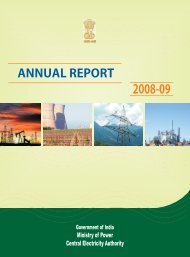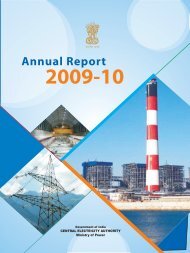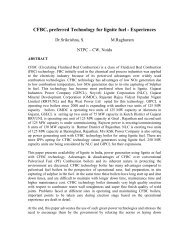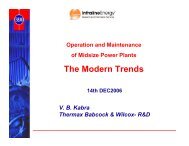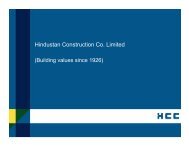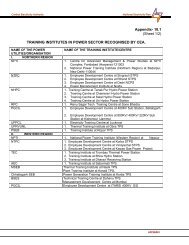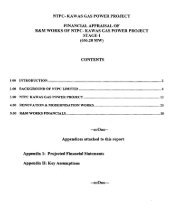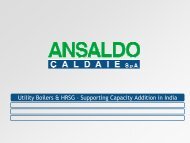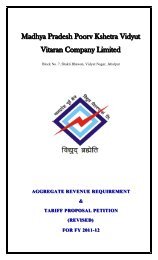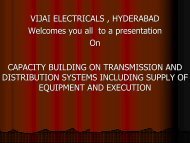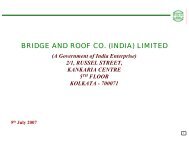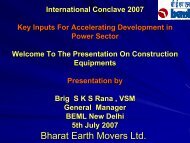discussion paper on parallel operation charge - Infraline
discussion paper on parallel operation charge - Infraline
discussion paper on parallel operation charge - Infraline
Create successful ePaper yourself
Turn your PDF publications into a flip-book with our unique Google optimized e-Paper software.
Rs. 0.74 / KVA / M<strong>on</strong>th. This is directly added and is to be paid by the CPP. (Refer<br />
secti<strong>on</strong> 6.4).<br />
(9) Rate of Parallel Operati<strong>on</strong> Charge (POC) in Rs. per kVA per M<strong>on</strong>th = (Charges for<br />
net support received by CPP in Rs. / Installed capacity in kVA) + No load <strong>charge</strong>s<br />
per kVA<br />
This rate can be worked out as average of the 10 sample CPPs included in the study.<br />
(10) Total PoC for individual CPP = Rate of Parallel Operati<strong>on</strong> Charge (POC) in Rs.per kVA<br />
per M<strong>on</strong>th X (Installed capacity of CPP in kVA - C<strong>on</strong>tracted Demand taken by CPP in<br />
kVA – C<strong>on</strong>tracted export power by CPP to the utility in kVA). Due weightage to the<br />
c<strong>on</strong>tract demand of the CPP and the c<strong>on</strong>tracted power for sale by the CPP is<br />
c<strong>on</strong>sidered.<br />
6.2 POWER QUALITY PARAMETERS:<br />
In this method, the <strong>parallel</strong> operati<strong>on</strong> <strong>charge</strong>s have been worked out <strong>on</strong> the basis of the<br />
quantum of distorti<strong>on</strong>/ power quality parameters like current THD and negative phase sequence<br />
current, etc. because there is cost <strong>on</strong> account of increased losses in the network and reduced<br />
equipment life due to higher stresses.<br />
The levy of <strong>parallel</strong> operati<strong>on</strong> <strong>charge</strong> is c<strong>on</strong>sidered as either 10% or 25 % of demand <strong>charge</strong>s<br />
depending <strong>on</strong> the type and quantum of distorti<strong>on</strong>, the harm<strong>on</strong>ic polluti<strong>on</strong> and negative phase<br />
sequence current imposed (10% for mild stress causing loads and 25% for heavy stress<br />
causing loads).<br />
The generati<strong>on</strong> and transmissi<strong>on</strong> related fixed <strong>charge</strong>s per kVA per m<strong>on</strong>th can be evaluated as<br />
below:<br />
(Total generati<strong>on</strong> related fixed cost in crores x 10 7 + Total transmissi<strong>on</strong> related fixed cost in<br />
crores x 10 7 ) ÷ (12 x 1000 x [Generati<strong>on</strong> capacity c<strong>on</strong>nected with CSEB Grid – Installed CPP<br />
capacity c<strong>on</strong>nected with CSEB Grid]<br />
= (508.01 x 10 7 + 185.61 x 10 7 ) ÷ {12 x 1000 x (5093.94 - 2253.69) / 0.9}<br />
= Rs.183.16 per kVA per m<strong>on</strong>th<br />
Therefore,<br />
Rate of POC (per kVA per M<strong>on</strong>th) = [ (Fixed <strong>charge</strong>s x Distorti<strong>on</strong> factor) + No load loss<br />
<strong>charge</strong>s]<br />
This <strong>charge</strong> would vary from CPP to CPP based <strong>on</strong> the installed capacity and distorti<strong>on</strong> factor of<br />
the respective CPP. Hence to have a uniform rate for all the CPPs, the average rate for ten<br />
26



